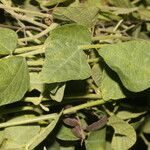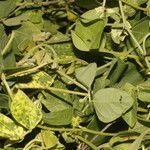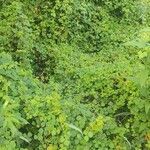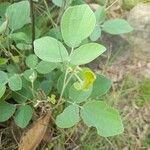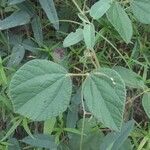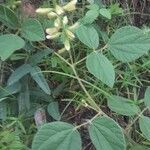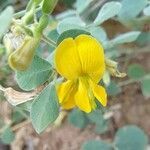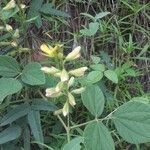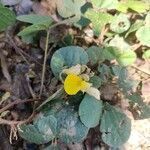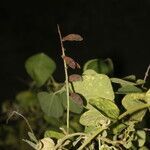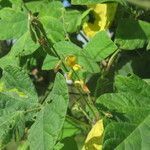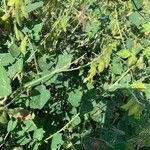0.3-1.0 cm long, the terminal leaflet with longer petiolule; petiole 1.2-4.0 cm long; strigose; stipels subulate, ca. 1.0 mm long; stipules linear to lanceolate, 3.0-10.0 mm long, 0.5-1.0 mm wide, persistent, villosulose. Inflorescence equal-ling or exceeding the leaves, 6.8-13.5 cm long, many flowered, the peduncle 1.2-7.0 cm long, the pedicels ca. 2.0 mm long; bracts lanceolate, ca. 1.0 mm long, caducous. Flowers with the calyx not exceeding the corolla, 2.0-4.0 mm long, the lobes 1.0-3.0 mm long, lanceolate, the upper lobes united part way, puber-ulose, gland dotted; corolla yellow with purplish striations, puberulose, gland dotted, 5.0-7.0 mm long, 3.0-5.0 mm wide, the claw 1.0 mm long, the wings oblong, 4.0-5.0 mm long, 1.75-2.0 mm wide, the claw 1.0 mm long, the keel falcate, 5.0-6.0 mm long, 1.5-2.0 mm wide, the claw 1.0-2.0 mm long; stamens 5.0-7.0 mm long. Fruits oblong, ovate, strigose, gland dotted, 0.9-1.5 cm long, 0.3-0.4 cm wide, the beak 0.5-1.0 mm long; seeds ovoid, brown, black mottled ca. 3.0 mm long, ca. 2.0 mm wide, hilum ovate, 0.5-1.0 mm long, the strophiole lobes narrow.
Herbs, annual. Stems twining, slender, sparsely pubescent. Leaves pinnately 3-foliolate; stipules small, lanceolate, usually 1-2 mm; petiole 1-4 cm, glabrous or sparsely pubescent; stipels extremely small; petiolules extremely short; leaflets ± membranous; terminal leaflet rhomboid-circular, 1.5-3 × 1.5-3 cm, sometimes wider than long, glabrous or sparsely villous, abaxially densely glandular, basal veins 3, apex obtuse or rounded, rarely shortly acute; lateral leaflets subequal to terminal leaflet or shorter, obliquely circular. Raceme 5-11 cm, axis slender, sparsely pubescent; bracts small, lanceolate, deciduous. Flowers 6-8 mm, slightly curved; pedicel extremely short. Calyx ca. 5 mm, sparsely pubescent; lobes lanceolate, slightly shorter than tube, lower one longer. Corolla yellow, longer than calyx, petals subequal; standard obovate-circular, base with 2 acute auricles; wings obovate-elliptic, auriculate; keels slightly curved, apex obtuse. Legume oblanceolate to ellipsoid, 1-2 × 0.4-0.5 cm, pubescent, 1-or 2-seeded. Fl. May-Oct, fr. Sep-Nov. 2n = 22.
Perennial climbing or prostrate herb, 0.1-1.5 m high, with glabrous to velvety stems from a woody rootstock. Leaves pinnately trifoliolate. Leaflets ovate, rhomboid or suborbicular, glabrescent to velvety, acute or obtuse at tip, densely gland-dotted below. Stipules small, linear-lanceolate. Inflorescences lax, axillary racemes. Flowers small, yellow, sometimes with dark red veins or flushed red. Flowering time Aug.-Apr.
A slender trailing herb. It has a woody rootstock. It has fine hairs. It can lie along the ground. It can be 5 m long. The leaves have 3 leaflets. The leaflets taper to a sharp point at the tip. There are 3 varieties. The flower are 5-10 mm long with a yellow standard. The pods are 20 mm long by 4-5 mm wide. They are narrowed at the base.
Herbaceous to suffrutescent vine; stems angular, puberulent to villosulose. Leaves trifoliolate, the leaflets ovate to ovate rhomboid to orbicular, 2.0-3.8 cm long, 1.0-3.0 cm wide, apically acute, basally cuneate to truncate, glabrous to finely strigulose above, puberulose to villosulose, gland dotted beneath; petiolule
